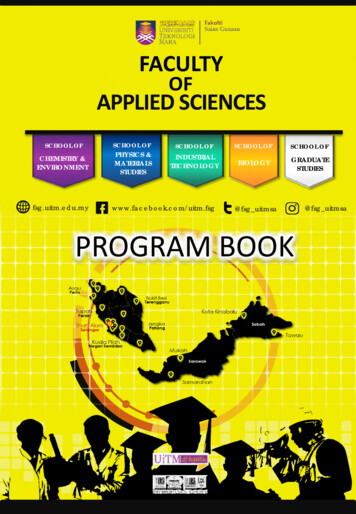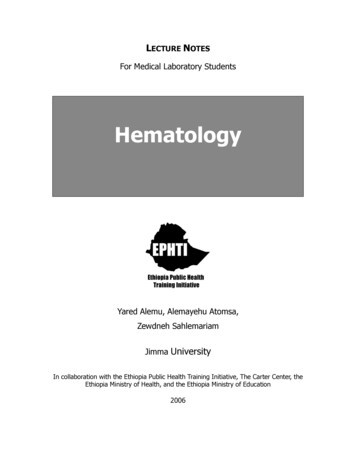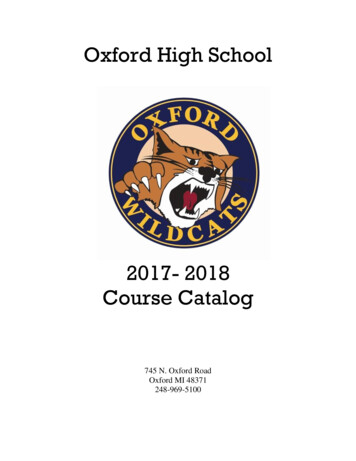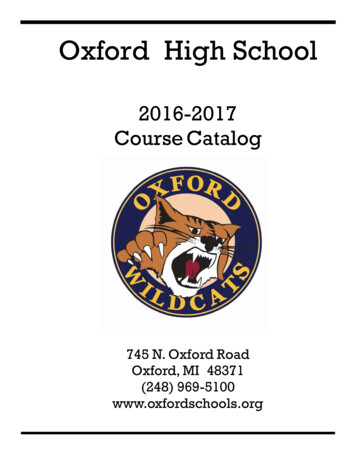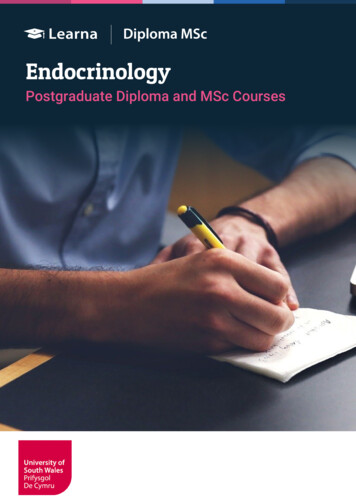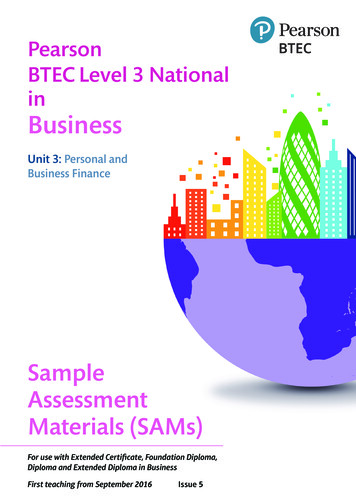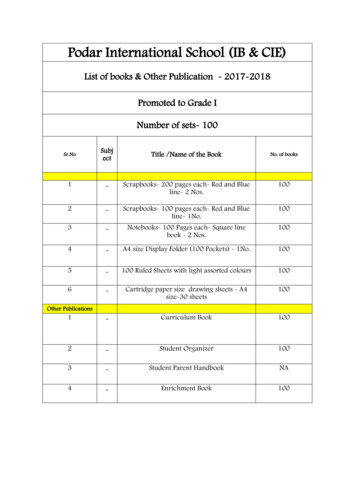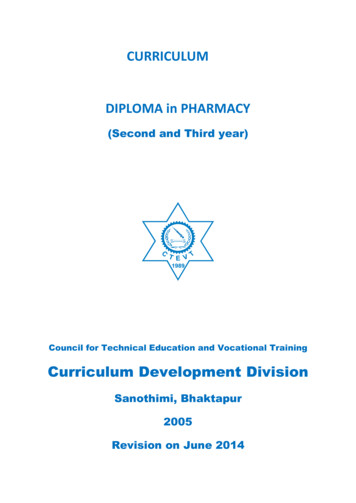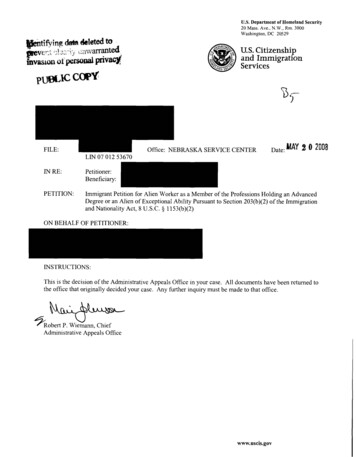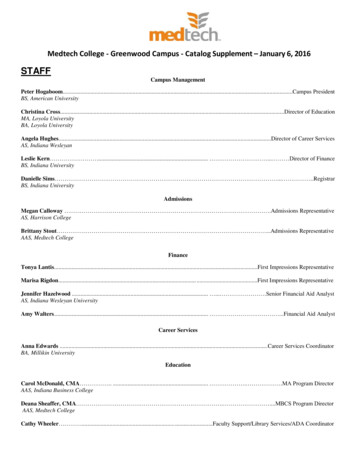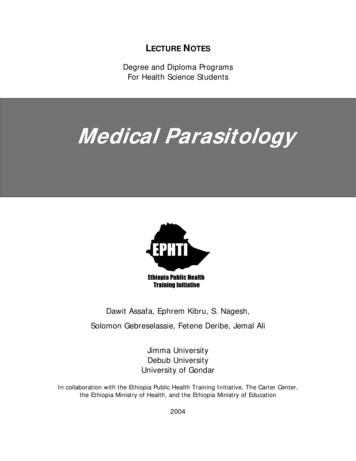
Transcription
LECTURE NOTESDegree and Diploma ProgramsFor Health Science StudentsMedical ParasitologyDawit Assafa, Ephrem Kibru, S. Nagesh,Solomon Gebreselassie, Fetene Deribe, Jemal AliJimma UniversityDebub UniversityUniversity of GondarIn collaboration with the Ethiopia Public Health Training Initiative, The Carter Center,the Ethiopia Ministry of Health, and the Ethiopia Ministry of Education2004
Funded under USAID Cooperative Agreement No. 663-A-00-00-0358-00.Produced in collaboration with the Ethiopia Public Health Training Initiative, The CarterCenter, the Ethiopia Ministry of Health, and the Ethiopia Ministry of Education.Important Guidelines for Printing and PhotocopyingLimited permission is granted free of charge to print or photocopy all pages of thispublication for educational, not-for-profit use by health care workers, students orfaculty. All copies must retain all author credits and copyright notices included in theoriginal document. Under no circumstances is it permissible to sell or distribute on acommercial basis, or to claim authorship of, copies of material reproduced from thispublication. 2006 by Dawit Assafa, Ephrem Kibru, S. Nagesh,, SolomonGebreselassie, Fetene Deribe, Jemal AliAll rights reserved. Except as expressly provided above, no part of this publication maybe reproduced or transmitted in any form or by any means, electronic or mechanical,including photocopying, recording, or by any information storage and retrieval system,without written permission of the author or authors.This material is intended for educational use only by practicing health care workers orstudents and faculty in a health care field.
PREFACEThis lecture note is useful to students of health science, medicine and otherstudents and academicians. It is believed to provide basic knowledge to studentson medical parasitology. It also serves as a good reference to parasitologists,graduate students, biomedical personnel, and health professionals. It aims atintroducing general aspects of medically important parasites prevalent in thetropics and in Ethiopia in particular. It is our belief that this note will contributemuch in alleviating the shortage of Parasitology texts.Students preparing to provide health care in their profession need solidfoundation of basic scientific knowledge of etiologic agents of diseases, theirdiagnosis and management. To face the fast growing trends of scientificinformation, students require getting education relevant to what they will be doingin their future professional lives. Books that are of manageable size areincreasingly important in helping students learn the seemingly overwhelmingamount of information they must absorb.i
ACKNOWLEDGEMENTSThe writers are indebted to the Ethiopian Public Health Initiative (EPHI) forencouragement and financial support. We thank all who contributed in the writeup of this lecture note and those involved in giving the secretarial service in allcolleges and Universities. Included in the acknowledgment are also the reviewersof the draft material, Dr. Habtamu and Ato Asrat Hailu who are currently staffs ofAAU-MF, Microbiology, Immunology, and Parasitology department. Theircomments were quiet constructive and well taken up.ii
TABLE OF CONTENTSTopicPagePreface . . iAcknowledgement. .iiTable of Contents. . iiiAbout the Authors . . viiList of Boxes and Tables . . viiiAbbreviations and Acronyms . .ixUNIT ONE: General Parasitology . . 1Association between parasite and host . . 1Effect of parasites on the host. . 4Basic concepts in medical parasitology . . 5Classification of medical parasitology . . 8General characteristics of medically important parasites . . 11(1) Protozoa . . 11(2) Heliminths . . 13(3) Arthropods . . 14UNIT TWO: Medical Protozology . . 17Introduction . . 17Classification of protozoa . . 20UNIT THREE: Amoebiasis . . 22Introduction . . 221.1. Entamoeba Histolytica . . 221.2. Other Amebae inhabiting the alimentary canal . . 271.3. Pathogenic free-living amoebae. . 35UNIT FOUR: Pathogenic Flagellates . . 37Introduction . . 372.1 Luminal Flagellates . . 37iii
2.1.1. Giardia Lamblia . . 372.1.2 Trichomonas vaginalis . . 412.1.3 Dientamoeba Fragilis . . 432.1.4 Other flagellates inhabiting the alimentary canal . . 442.2. Haemoflagelates . . 472.2.1 Leishmania Species . . 472.2.1.1 Visceral Leishmaniasis . . 472.2.1.2 Old world cutaneous leishmaniasis (Oriental sore) . . 502.2.1.3 New world cutaneous and mucocutaneous leishmaniasis522.2.2 Trypanosomiasis . . 532.2.2.1 African trypanosomiasis . . 542.2.2.2 American trypanosomiasis . . 57UNIT FIVE: Medically important ciliates. . 61Balantidiasis . . 61UNIT SIX: COCCIDIA (SPOROZOA) . . 634.1 Malaria . . 634.1.1 Plasmodium falciparum . . 664.1.2 Plasmodium vivax . . 694.1.3 Plasmodium malariae. . 704.1.4 Plasmodium ovale . . 714.2 Other cocidian parasites . . 74Review Questions . . 80UNIT SEVEN: Medical heminthology. . 82UNIT EIGHT: Medically important treatodes (Flukes) . . 841.1. Blood Flukes . . 841.1.1. Schistosomiasis (Bilharziasis) . . 84Schistosoma Mansoni . . 85Urinary Scistosomiasis . . 85Schistosoma Japonium . . 86Schistosoma Intercalatum . . 861.2. Intestinal Flukes . . 89iv
1.3. Liver Flukes. . 891.4. Lung Flukes . . 89UNIT NINE: Nematodes (Round Worms) . . 89General Characteristics of nematodes . . 902.1. Intestinal nematodes with tissue stage . . 912.1.1. Ascaris lumbricoides . . 912.1.2. Hook worms . . 932.1.2.1. Ancylostoma duodenale . . 932.1.2.2. Necator Americanus. . 942.1.3 Larva migrans . . 96A. Cutaneous larva migrans (creeping eruption) . . 96B. Visceral larva migrans . . 962.1.4 Strongyloides stercoralis . . 982.2. Intestinal nematodes without tissue stage . . 1002.2.1. Enterobius vermicularis (Pin worm or thread worm) . . 1002.3. Tissue nematodes . . 1042.3.1. Filarial worms . . 1042.3.1.1. Wuchereria Bancrofti. . 1052.3.1.2. Onchocerca Volvulus . . 1072.3.1.3. Loa Loa . . 1102.3.2. Dracunculus Medinensis (Guinea Worm or Medina Worm) 1112.3.3. Trichinosis . . 113UNIT TEN: Cestodes (Tapeworms) . . 116Introduction . . 1163.1. Hymenolepis nana (Dwarf Tapeworm) . . 1163.2. Hymenolepis Diminuta (Rat tapeworm) . . 1173.3. Echinococcus . . 1183.3.1 Echinococcus Granulosus (Dog Tape Worm) . . 1183.3.2. Echinococcus multilocularis . . 1203.4. Taenia Saginata (Beef Tape Worm) . . 1203.5. Taenia Solium (Pork Tape Worm) . . 123v
3.6. Diphylobotrium Latum (Fish Tapeworm or Broad Tape Worm) . 124UNIT ELEVEN: Medical Entomology . . 127Introduction . . 127Arthropods . . 127Biology of Arthopods . . 128Development of Arthropods . . 130Importance of Arthropods in Parasitology . . 130Classification of Arthropods . . 132Medical conditions related to arthropods . . 134A. Fly related conditions . . 134B. Mosquito related conditions . . 135C. Flea related conditions . . 135D. Lice related conditions . . 135E. Bug related conditions . . 136F. Tick related conditions . . 136G. Mite related conditions . . 136Vector control measures . . 136(1) Mechanical Methods . . 136(2) Ecological control . . 136(3) Chemical methods . . 137(4) Biological methods . . 137(5) Genetic control . . 137Summary . . 138Learning Activity . . 138References . . 138Glossary . . 139vi
ABOUT THE AUTHORSSolomon Gebreselassie (M.D., M.Sc): assistant professor of anddepartment head of Microbiology, Parasitology, and Immunology,Jimma UniversityDawit Assefa(M.D): Lecturer and department head of Biomedical andBehavioral Sciences, Awassa College of Health biologyandParasitology, Awassa College of Health Sciences.Nagesh S. (MSc.): Lecturer of Microbiology and Parasitology,Awassa College of Health Sciences.Fetene Deribe(MSc): Lecturer of Microbiology and Parasitology,Jimma UniversityJemal Ali (BSc in MLT): Gondor University Collegevii
LIST OF BOXES AND TABLESBox 1: different kinds of parasites ------2Box 2: different kinds of Hosts ----------3Table 1: classification of pathogenic 2Table 2: differentiating features of --13viii
ABBREVIATIONS AND ACRONYMSCNS: Central nervous systemCSF: Cerebro-spinal fluidDEC: Diethyl carbamazineELISA: Enzyme linked immunosorbent assayPO: Per Os (through mouth)HIV: Human Immunodeficiency VirusAIDS: Acquired Immune Deficiency Syndromeix
UNIT ONEGENERAL PARASITOLOGYLEARNING OBJECTIVESAt the end of this section the student is expected to: Discuss the various types of parasites and hosts. Explain the relationship between a parasite and the host and their effects. Discuss in detail the classification of medically important parasites. Explain the difference between the Cestodes, Nematodes, Trematodes andprotozoaINTRODUCTIONMan and other living things on earth live in an entangling relationship with each other.They don’t exist in an isolated fashion. They are interdependent; each forms a strand inthe web of life. Medical parasitology is the science that deals with organisms living inthe human body (the host) and the medical significance of this host-parasiterelationship.ASSOCIATION BETWEEN PARASITE AND HOSTA parasite is a living organism, which takes its nourishment and other needs from ahost; the host is an organism which supports the parasite. The parasites included inmedical parasitology are protozoa, helminthes, and some arthropods. (See box 1 forbroader classification of parasites). The hosts vary depending on whether they harborthe various stages in parasitic development. (See box 2)1
BOX 1. DIFFERENT KINDS OF PARASITES Ectoparasite – a parasitic organism that lives on the outer surface of its host, e.g.lice, ticks, mites etc. Endoparasites – parasites that live inside the body of their host, e.g. Entamoebahistolytica. Obligate Parasite - This parasite is completely dependent on the host during asegment or all of its life cycle, e.g. Plasmodium spp. Facultative parasite – an organism that exhibits both parasitic and non-parasiticmodes of living and hence does not absolutely depend on the parasitic way oflife, but is capable of adapting to it if placed on a host. E.g. Naegleria fowleri Accidental parasite – when a parasite attacks an unnatural host and survives. E.g.Hymenolepis diminuta (rat tapeworm). Erratic parasite - is one that wanders in to an organ in which it is not usually found.E.g. Entamoeba histolytica in the liver or lung of humans.Most of the parasites which live in/on the body of the host do not cause disease(non-pathogenic parasites). In Medical parasitology we will focus on most of the diseasecausing (pathogenic) parasites. However, understanding parasites which do notordinarily produce disease in healthy (immunocompetent) individuals but do causeillness in individuals with impaired defense mechanism (opportunistic parasites) isbecoming of paramount importance because of the increasing prevalence of HIV/AIDSin our country.2
BOX 2. DIFFERENT KINDS OF HOSTS Definitive host – a host that harbors a parasite in the adult stage or where the parasiteundergoes a sexual method of reproduction. Intermediate host - harbors the larval stages of the parasite or an asexual cycle ofdevelopment takes place. In some cases, larval development is completed in twodifferent intermediate hosts, referred to as first and second intermediate hosts. Paratenic host – a host that serves as a temporary refuge and vehicle for reaching anobligatory host, usually the definitive host, i.e. it is not necessary for the completion ofthe parasites life cycle. Reservoir host – a host that makes the parasite available for the transmission toanother host and is usually not affected by the infection. Natural host – a host that is naturally infected with certain species of parasite. Accidental host – a host that is under normal circumstances not infected with theparasite.There is a dynamic equilibrium which exists in the interaction of organisms. Anyorganism that spends a portion or all of its life cycle intimately associated with anotherorganism of a different species is considered as Symbiont (symbiote) and thisrelationship is called symbiosis (symbiotic relationships).The following are the three common symbiotic relationships between two organisms:Mutualism - an association in which both partners are metabolically dependent uponeach other and one cannot live without the help of the other; however, none of thepartners suffers any harm from the association. One classic example is the relationshipbetween certain species of flagellated protozoa living in the gut of termites. Theprotozoa, which depend entirely on a carbohydrate diet, acquire their nutrients fromtermites. In return they are capable of synthesizing and secreting cellulases; thecellulose digesting enzymes, which are utilized by termites in their digestion.3
Commensalism - an association in which the commensal takes the benefit withoutcausing injury to the host. E.g. Most of the normal floras of the humans’ body can beconsidered as commensals.Parasitism - an association where one of the partners is harmed and the other lives atthe expense of the other. E.g. Worms like Ascaris lumbricoides reside in thegastrointestinal tract of man, and feed on important items of intestinal food causingvarious illnesses.Once we are clear about the different types of associations between hosts andparasites, we can see the effect the parasite brings to the host and the reactions whichdevelop in the host’s body due to parasitic invasion.EFFECT OF PARASITES ON THE HOSTThe damage which pathogenic parasites produce in the tissues of the host may bedescribed in the following two ways;(a) Direct effects of the parasite on the host Mechanical injury - may be inflicted by a parasite by means of pressure as it growslarger, e.g. Hydatid cyst causes blockage of ducts such as blood vesselsproducing infraction. Deleterious effect of toxic substances- in Plasmodium falciparum production oftoxic substances may cause rigors and other symptoms. Deprivation of nutrients, fluids and metabolites -parasite may produce disease bycompeting with the host for nutrients.(b) Indirect effects of the parasite on the host:Immunological reaction: Tissue damage may be caused by immunologicalresponse of the host, e.g. nephritic syndrome following Plasmodium infections.Excessive proliferation of certain tissues due to invasion by some parasites canalso cause tissue damage in man, e.g. fibrosis of liver after deposition of the ova ofSchistosoma.4
BASIC CONCEPTS IN MEDICAL PARASITOLOGYIn medical parasitology, each of the medically important parasites are discussed underthe standard subheadings of morphology, geographical distribution, means of infection,life cycle, host/parasite relationship, pathology and clinical manifestations of infection,laboratory diagnosis, treatment and preventive/control measures of parasites. In thesubsequent section some of these criteria are briefly presented.Morphology - includes size, shape, color and position of different organelles in differentparasites at various stages of their development. This is especially important inlaboratory diagnosis which helps to identify the different stages of development anddifferentiate between pathogenic and commensal organisms. For example,Entamoeba histolytica and Entamoeba coli.Geographical distribution - Even though revolutionary advances in transportation hasmade geographical isolation no longer a protection against many of the parasiticdiseases, many of them are still found in abundance in the tropics. Distribution ofparasites depends upon:a. The presence and food habits of a suitable host: Host specificity, for example, Ancylostoma duodenale requires man as a hostwhere Ancylostoma caninum requires a dog. Food habits, e.g. consumption of raw or undercooked meat or vegetablespredisposes to Taeniasisb. Easy escape of the parasite from the host- the different developmental stages of aparasite which are released from the body along with faeces and urine are widelydistributed in many parts of the world as compared to those parasites whichrequire a vector or direct body fluid contact for transmission.c. Environmental conditions favoring survival outside the body of the host, i.e.temperature, the presence of water, humidity etc.d. The presence of an appropriate vector or intermediate host – parasites that do notrequire an intermediate host (vector) for transmission are more widely distributedthan those that do require vectors.5
Once we are clear about the geographical distribution and conditions favoring survival inrelation to different parasites, effective preventive and control measures can more easilybe devised and implemented.Life cycle of parasites - the route followed by a parasite from the time of entry to thehost to exit, including the extracorporeal (outside the host) life. It can either be simple,when only one host is involved, or complex, involving one or more intermediate hosts. Aparasite’s life cycle consists of two common phases one phase involves the route aparasite follows inside the body. This information provides an understanding of thesymptomatology and pathology of the parasite. In addition the method of diagnosis andselection of appropriate medication may also be determined. The other phase, the routea parasite follows outside of the body, provides crucial information pertinent toepidemiology, prevention, and control.Host parasite relationship - infection is the result of entry and development within thebody of any injurious organism regardless of its size. Once the infecting organism isintroduced into the body of the host, it reacts in different ways and this could result in:a. Carrier state - a perfect host parasite relationship where tissue destruction by aparasite is balanced with the host’s tissue repair. At this point the parasite andthe host live harmoniously, i.e. they are at equilibrium.b. Disease state - this is due to an imperfect host parasite relationship where theparasite dominates the upper hand. It can result either from lower resistance ofthe host or a higher pathogenecity of the parasite.c. Parasite destruction – occurs when the host takes the upper hand.Laboratory diagnosis – depending on the nature of the parasitic infections, thefollowing specimens are selected for laboratory diagnosis:a) Blood – in those parasitic infections where the parasite itself in any stage of itsdevelopment circulates in the blood stream, examination of blood film forms oneof the main procedures for specific diagnosis. For example, in malaria theparasites are found inside the red blood cells. In Bancroftian and Malayanfilariasis, microfilariae are found in the blood plasma.6
b) Stool – examination of the stool forms an important part in the diagnosis ofintestinal parasitic infections and also for those helminthic parasites that localizein the biliary tract and discharge their eggs into the intestine.In protozoan infections, either trophozoites or cystic forms may be detected; theformer during the active phase and the latter during the chronic phase. Example,Amoebiasis, Giardiasis, etc.In the case of helmithic infections, the adult worms, their eggs, or larvae arefound in the stool.c) Urine – when the parasite localizes in the urinary tract, examination of the urinewill be of help in establishing the parasitological diagnosis. For example inurinary Schistosomiasis, eggs of Schistosoma haematobium are found in theurine. In cases of chyluria caused by Wuchereria bancrofti, microfilariae arefound in the urine.d) Sputum – examination of the sputum is useful in the following: In cases where the habitat of the parasite is in the respiratory tract, as inParagonimiasis, the eggs of Paragonimus westermani are found. In amoebic abscess of lung or in the case of amoebic liver abscess burstinginto the lungs, the trophozoites of E. histolytica are detected in the sputum.e) Biopsy material - varies with different parasitic infections. For example spleenpunctures in cases of kala-azar, muscle biopsy in cases of Cysticercosis,Trichinelliasis, and Chagas’ disease, Skin snip for Onchocerciasis.f) Urethral or vaginal discharge – for Trichomonas vaginalisIndirect evidences – changes indicative of intestinal parasitic infections are:a. Cytological changes in the blood – eosiniphilia often gives an indicationof tissue invasion by helminthes, a reduction in white blood cell count isan indication of kala-azar, and anemia is a feature of hookworminfestation and malaria.b. Serological tests – are carried out only in laboratories where specialantigens are available.7
Treatment – many parasitic infections can be cured by specific chemotherapy. Thegreatest advances have been made in the treatment of protozoal diseases.For the treatment of intestinal helminthiasis, drugs are given orally for direct action onthe helminthes. To obtain maximum parasiticidal effect, it is desirable that the drugsadministered should not be absorbed and the drugs should also have minimum toxiceffect on the host.Prevention and control - measures may be taken against every parasite infectivinghumans. Preventive measures designed to break the transmission cycle are crucial tosuccessful parasitic eradication. Such measures include: Reduction of the source of infection- the parasite is attacked within the host, therebypreventing the dissemination of the infecting agent. Therefore, a prompt diagnosisand treatment of parasitic diseases is an important component in the prevention ofdissemination. Sanitary control of drinking water and food. Proper waste disposal – through establishing safe sewage systems, use of screenedlatrines, and treatment of night soil. The use of insecticides and other chemicals used to control the vector population. Protective clothing that would prevent vectors from resting in the surface of the bodyand inoculate pathogens during their blood meal. Good personal hygiene. Avoidance of unprotected sexual practices.CLASSIFICATION OF MEDICAL PARASITOLOGYParasites of medical importance come under the kingdom called protista and animalia.Protista includes the microscopic single-celled eukaroytes known as protozoa. ormspossessingwell-differentiated tissues and complex organs belonging to the kingdom animalia. MedicalParasitology is generally classified into: Medical Protozoology - Deals with the study of medically important protozoa.8
Medical Helminthology - Deals with the study of helminthes (worms) that affectman. Medical Entomology - Deals with the study of arthropods which cause or transmitdisease to man.Describing animal parasites follow certain rules of zoological nomenclature and eachphylum may be further subdivided as follows:Super classPhylumSubphylumClassSuper familyOrderSubclassFamilySubfamily9GenusSpecies
FIGURE 1. CLASSIFICATION OF MEDICALLY IMPORTANT PARASITESPROTOZOAMETAZOA (HELIMINTHS)Sarcodina (Amoebae):Platyhelminthes:(a) Genus, Entameba:Trematodea:E.g. Entameba histolytica(a) Genus Schistosoma(b) Genus EndolimaxE.g. S. mansoniE.g. Endolimax nana(b) Genus Fasciola(c) Genus IodamebaE.g. F. hepaticaE.g. Iodameba butchliiCestoda:(d) Genus Dientmeba(a) Genus DiphylobotriumE.g. Dientameba fragilisE.g. D. latum(b) Genus TaeniaMastigophora (Flagellates):(a) Genus GiardiaE.g. T. saginataE.g. G. lamblia(c) Genus Echinococcus(b) Genus TrichomonasE.
department head of Microbiology, Parasitology, and Immunology, Jimma University Dawit Assefa(M.D): Lecturer and department head of Biomedical and Behavioral Sciences, Awassa College of Health Sciences. Ephrem Kibru(M.D): Assistant Lecturer of Microbiology and Parasitology, Awassa College of Health Sciences. Nagesh S. (MSc.):
